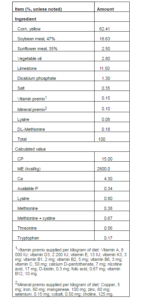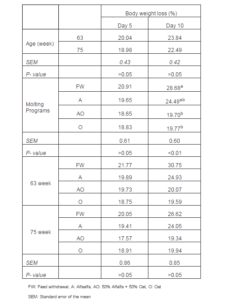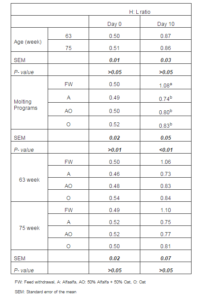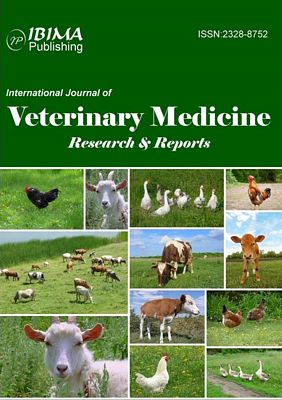Introduction
Induced molting is practiced to give the flock a rest at the end of a period of egg production and to extend the productive life of their hens (North and Bell 1990). There are several force molting methods. Feed withdrawal has been the most popular due easy of application, economic benefits and agreeable postmolt performance (Bell 2003). However, these programs raise concern about animal welfare because it is thought that they may be harmful to hens (Webster 2003). For this reason, researchers have examined alternative molting methods. These methods included high zinc (Sarica et al 1996; Yilmaz and Sahan 2003), low sodium concentrations (Berry and Brake 1985), wheat middlings (Biggs et al 2003), barley (Onbasilar and Erol 2007), cottonseed meals (Davis et al 2002), jojoba meal (Vermaut et al 1997), alfalfa (Donalson et al 2005; Landers et al 2005; Aygun and Olgun 2010; Aygun, 2013), and oat (Kocak et al 1980; Yetisir et al 1985; Tona et al 2002; Aygun and Yetisir 2009), which have been successfully used for induced molting. The feedstuff which used for alternative induced molting has usually insoluble plant fiber and low energy (alfalfa, cottonseed, grape pomace, and wheat middlings).
To the best of our knowledge, no previous studies have been carried out specifically on the effects of hen age and nonfeed withdrawal methods on body weight loss and heterophil: lymphocyte ratio during molt period in laying hens. There is only one study that investigated the effects of hen age on post molt performance. This is the first study that the effects of nonfeed withdrawal methods on some parameters during molting period. The aim of this study was to determine the effects of hen age and force molting programs on body weight loss, cease egg production and heterophil: lymphocyte ratio during molt period.
Materials and Methods
A total of 320 Hy-Line W36 laying hens (63 and 75 week of age) were obtained from The Research and Application Farm at the Faculty of Agriculture at Selcuk University (Konya, Turkey). Hens were placed four hens per cage (500 cm2/hen), and 2 wk were allowed for acclimation. During this time the hens were fed a layer diet (Table 1) and the photoperiod was 16L:8D. After the acclimation, the hens were randomly assigned to experimental groups (five replicates of 8 hens for each treatment). The experimental design of the study was a 2 × 4 factorial arrangement of a completely randomized design. Eight treatments were compared in a 2 x 4 factorial arrangement with 2 age treatment (63 and 75 week of age) and 4 force molting treatments during 10 days [feed withdrawal (FW), 100% alfalfa (A), 50% alfalfa and 50%oat (AO), and 100% oat (O)]). Thus 320 hens used in 8 treatments (2 age x 4 molting methods; 5 replicated) with 40 hens used in each. Alfalfa is very high in crude fiber (20-24%), has a moderate protein level (17-20 %) and has a low metabolizable energy (ME) value (1200-1600 kcal/kg) (NRC 1994) . The oat has got insoluble high fiber (10-11%) and moderate energy (2500 kcal/kg) (NRC, 1994), The respective diet and water were allowed ad-libitum, and hens were placed on an artificial lighting program of 8L:16D during the 10 d molt period (Donalson et al 2005; Petek et al 2008; Aygun and Olgun 2010; Aygun, 2013).
Egg production and mortality were recorded daily throughout during molt period. Hens were weighed on day 0, day 5 and day 10 to calculate body weight (BW) loss during molt period. Blood samples were taken from the brachial vein of one hen per replicate on day 0 and day 10 (end of the molt). Each hen sampled on day 0 was leg-banded after blood was drawn, and the same hen from each replicate group was sampled on day 10. The smears were stained with May-Grunwald-Giemsa stain. The total leukocyte count included heterophils, lymphocytes, monocytes, basophils and eosinophils. A total of 100 cells were counted for each ratio. The heterophil:lymphocyte (H: L) ratio was calculated by dividing the number of heterophils by the number of lymphocytes (Gross and Siegel 1983).
Statistical Analysis
Body weight loss, heterophil:lymphocyte ratio and cease egg production were analyzed using the general linear model (GLM). The least significant difference (LSD) test was applied to detect statistically significant differences between groups. All analyses were carried out using Minitab Version 14 (Minitab Inc., State College, PA, USA).
Table 1: Composition of the Diet

Results and Discussion
Body Weight (BW) Loss
The effects of hen age and force molting programs on BW loss are shown in Table 2. Neither age nor molting programs had a significant effect on BW loss at 5 day of molt period. The hen age had no significant effect on BW loss at the end of the molt period (day 10). However, there were significant (p<0.01) differences between force molting programs for BW lost at the end of the molt period (day 10). The FW treatment (28.68%) significantly (p<0.01) higher BW loss than AO (19.70%) and O (19.77%) treatments. But no significant differences were observed between FW (28.68%) and A (24.49%) treatments. Similar results were found by Donalson et al (2005) who reported that hens fed 100% alfalfa were not significantly different from FW hens.
Table 2: Effects of Hen Age and Force Molting Programs on BW Loss during Molt Period

There were no significant differences between A (24.49%) and AO (19.70%) and O (19.77%) programs for BW loss at day 10 of the molt period. This agrees with the findings of Khajali et al (2008), Petek and Alpay (2008), Aygun and Olgun (2010), who reported that no significant differences in BW loss were observed among nonfeed withdrawal programs. BW losses in all treatments are in agreement with the report of Ruszler (1998) who state that for successful molting the BW loss should be between 15-40% during molting period. BW loses value of AO (19.70%) and O (19.77%) is similar to the values reported by Petek and Alpay (2008), Aygun and Olgun (2010), and Aygun (2013).
Egg Production Cease
There were no significantly differences in cease egg production between 63 week (5.85 day) and 73 week (5.85 day) age hens (Table 3). No significant differences in cease egg production were found among FW (5.70 day), A (6.00 day), AO (5.80 day), and O (5.90 day) treatments. This agrees with the findings of Donalson et al (2005) who reported that no significant differences in cease egg production between hens molted by alfalfa and feed withdrawal treatment. Gutierrez et al (2008) and Willis et al (2009), who stated that hens molted with nonfeed withdrawal ceased production on day 6. North and Bell (1990) stated that short resting periods can get a flock back to its peak of production in a month from the initiation of the molt.
Table 3: Effects of Hen Age and Force Molting Programs on Cease Egg Production during Molt Period

Heterophil: Lymphocyte (H: L) Ratio
The effects of hen age and force molting programs on H: L ratio are illustrated in Table 4. No significant differences for H: L ratio between 63 week (0.50) and 75 week (0.51) age hens at the beginning of the molt period. There were no significant differences for H: L ratio among FW (0.50), A (0.49), AO (0.50), and O (0.52) treatments at the beginning of the molt period. At the end of the molt period, No significant differences in H: L ratio between 63 week (0.87) and 75 week (0.86) age hens were observed. However, hens molted with FW (1.08) have a significantly higher H: L ratio than hens molted with A (0.74), AO (0.80), and O (0.83). No significant differences were observed in H: L ratio among nonfeed withdrawal treatments. This result agrees with the findings of Landers (2004) and Hnin et al (2009), who stated that hens molted by feed deprivation have a significantly higher H: L ratio when compared to birds that were not molted and birds molted by nonfeed withdrawal methods including alfalfa, rice, wheat or corn. However, Biggs et al (2004) stated that no differences were observed among feed removal treatments versus several nonfeed removal treatments including wheat and corn H: L ratios during the molt period.
Table 4: Effects of Hen Age and Force Molting Programs on H: L Ratio during Molt Period

Mortality
No death was observed in all treatment during the molt period. This result agree with by Aygun and Olgun (2010) and Aygun (2013), who reported that there were no death in FW and noon feed withdrawal treatments during molt period. The mortality was ranging from 1.20 to 8.3% among molt treatments during molt period in previous studies (Altan et al 1989; Biggs et al 2003; Petek and Alpay 2008; Aygun and Yetisir 2009).
Conclusion
The results of this study indicated that hen age did not influence the body weight loss, egg production cease and stress as indicated by H: L during the molt period in our experimental conditions. The producer may be prefer to induced molting depend on egg prices between 63 and 75 week of age. In addition, nonfeed withdrawal methods can be used successfully alternative to feed withdrawal methods for force molting because they have similar or smaller weight loss, similar egg production cease, and smaller H: L.
Acknowledgement
The authors would like to acknowledge the financial support received from the Turkish National Scientific Research Projects Coordinator (Selcuk University), project number (10401045).
References
Altan, O., Kocak, C., Altan, A. & Akbas, Y. (1989). ‘Cesitli Tuy Değistirme Yontemlerinin Yumurta Tavuklarında Kimi Verim Ozelliklerine Etkileri,’ Ege Universitesi Ziraat Fakultesi Dergisi, 26 (3) 37-47. (In Turkish, With English Abstract)
Aygun A. (2013). “Effects of Force Molting on Eggshell Colour, Egg Production and Quality Traits in Laying Hens,”Revue de Medecine Veterinaire, 164 (2) 46-51.
Publisher – Google Scholar
Aygun, A. & Yetisir, R. (2009). “Researches on the Responses of Different Hybrid Layers with Respect to Egg Production Performances to Forced Molting Programs with and without Feed Withdrawal,” Journal of Animal Veterinary Advances, 8 2680-2686.
Publisher – Google Scholar
Aygun, A. & Olgun, O. (2010). “The Effect of Nonfeed and Feed Withdrawal Molting Methods on Molt and Postmolt Performance in Laying Hens,” Trends in Animal Veterinary Sciences, 1 1-4.
Publisher – Google Scholar
Bell, D. D. (2003). “Historical and Current Molting Practices in the US Table Egg Industry,” Poultry Science, 82 965-970.
Publisher – Google Scholar – British Library Direct
Berry, W. D. & Brake, J. (1985). “Comparison of Parameters Associated with Molt Induced by Fasting Zinc and Low Dietary Sodium in Caged Layers,” Poultry Science, 64 2027—2036.
Publisher – Google Scholar
Biggs, P. E., Douglas, M. W., Koelkebeck, K. W. & Parsons, C. M. (2003). “Evaluation of Nonfeed Removal Methods for Molting Programs,” Poultry Science, 82 749-753.
Publisher – Google Scholar – British Library Direct
Biggs, P. E., Persia, M. E., Koelkebeck, K. W. & Parsons, C. M. (2004). “Further Evaluation of Nonfeed Removal Methods for Molting Programs,” Poultry Science, 83 745-752.
Publisher – Google Scholar – British Library Direct
Davis, A. J., Lordelo, M. M. & Dale, N. (2002). ‘The Use of Cottonseed Meal with or Without Added Soap Stock in Laying Hen Diets,’ The Journal of Applied Poultry Research, 11 127-133.
Google Scholar
Donalson, L. M., Kim, W. K. Woodward, C. L., Herrera, P., Kubena, L. F., Nisbet, D. J. & Ricke, S. C. (2005). “Utilizing Different Ratios of Alfalfa and Layer Ration for Molt Induction and Performance in Commercial Laying Hens,” Poultry Science, 84 362-369.
Publisher – Google Scholar
Gross, W. B. & Siegel, H. S. (1983). “Evaluation of the Heterophil/Lymphocyte Ratio as a Measure of Stress in Chickens,“ Avian Diseases, 27 972-979.
Publisher – Google Scholar
Gutierrez, O., Zhang, C., Caldwell, D. J., Carey, J. B., Cartwright, A. L. & Bailey, C. A. (2008). “Guar Meal Diets as an Alternative Approach to Inducing Molt and Improving Salmonella Enteritidis Resistance in Late-Phase Laying Hens,”Poultry Science, 87 536—540.
Publisher – Google Scholar – British Library Direct
Khajali, F., Karimi, S. & Akhri, M. R. (2008). “Physiological Response and Postmolt Performance of Laying Hens Molted by Non-Feed Removal Methods,” American Journal of Animal and Veterinary Sciences, 3 13-17.
Publisher – Google Scholar
Kocak, C., Gonul, T., Mutaf, Y. & Onder, M. (1980). ‘Cesitli Genotipten Tavuklarda Yumurta Uretim Suresinin Zorlamali Tuy Degistirme Yoluyla Uzatilmasi Olanaklari,’ Ege Universitesi Ziraat Fakultesi Dergisi, 17 135-149. (In Turkish, With English Abstract)
Landers, K. L. (2004). “Evaluation of the Use of Alfalfa Diets as an Alternative to Feed Deprivation for the Induction of Molt in Commercial Laying Hens,” Phd Thesis. The Office of Graduate Studies of Texas A&M University. College Station. USA.
Publisher – Google Scholar
Landers, K. L., Woodward, C. L., Li, X., Kubena, L. F., Nisbet, D. J. & Ricke, S. C. (2005). “Alfalfa as a Single Dietary Source for Molt Induction in Laying Hens,” Bioresource Technology, 96 565-570.
Publisher – Google Scholar
North, M. O. & Bell, D. D. (1990). Commercial Chicken Production Manual, 4th Ed. Chapman and Hall, New York, NY, Pp: 433-452.
Publisher – Google Scholar
NRC, (1994). Nutrient Requirement of Poultry, 9th Ed., National Academy of Sciences, Washington, DC, Pp: 176.
Publisher
Onbasilar, E. E. & Erol, H. (2007). “Effects of Different Forced Molting Methods on Postmolt Production, Corticosterone Level, and Immune Response to Sheep Red Blood Cells in Laying Hens,” The Journal of Applied Poultry Research, 16 529-536.
Publisher – Google Scholar – British Library Direct
Petek, M. & Alpay, F. (2008). “Utilization of Grain Barley and Alfalfa Meal as Alternative Molt Induction Programmes for Laying Hens: Body Weight Losses and Egg Production Traits,” Bulgarian Journal of Veterinary Medicine, 11 243-249.
Publisher – Google Scholar
Petek, M., Gezen, S. S. Alpay, F. & Cibik, R. (2008). “Effects of Non-Feed Removal Molting Methods on Egg Quality Traits in Commercial Brown Egg Laying Hens in Turkey,” Tropical Animal Health and Production, 40 413-417.
Publisher – Google Scholar – British Library Direct
Ruszler, P. L. (1998). “Health and Husbandry Considerations of Induced Molting,” Poultry Science, 77 1789-1793.
Publisher – Google Scholar – British Library Direct
Sarica, M., Ozturk, E. & Karacay, N. (1996). ‘Degisik Zorlamali Tuy Dokum Programlarinin Yumurta Verimi Ve Yumurta Kalitesi Uzerine Etkileri,’ Turkish Journal of Veterinary Animal Sciences, 20 143-150. (In Turkish, With English Abstract)
Google Scholar
Soe, H. Y., Yayota, M. & Ohtani, S. (2009). “Effects of Molt-Induction Period on Induction of Molt and Post-Molt Performance in Laying Hens,” Journal of Poultry Science, 46 203-211.
Publisher – Google Scholar
Tona, K., Bamelis, F., De Ketelaere, B., Bruggeman, V. & Decuypere, E. (2002). “Effect of Induced Molting on Albumen Quality, Hatchability, and Chick Body Weight from Broiler Breeders,” Poultry Science, 81 327—332.
Publisher – Google Scholar – British Library Direct
Vermaut, S., De Coninck, K. Flo, G., Cokelaere, M., Onagbesan, M. & Decuypere, E. (1997). “Effect of Deoiled Jojoba Meal on Feed Intake in Chickens: Satiating or Taste Effect?,” Journal of Agricultural and Food Chemistry, 45 3158—3163.
Publisher – Google Scholar – British Library Direct
Webster, A. B. (2003). “Physiology and Behavior of the Hen during Induced Molt,” Poultry Science, 82 992-1002.
Publisher – Google Scholar – British Library Direct
Willis, W. L., Isikhuemhen, O. S., Allen, J. W., Byers, A., King, K. & Thomas, C. (2009). “Utilizing Fungus Myceliated Grain for Molt Induction and Performance in Commercial Laying Hens,” Poultry Science, 88 2026-2032.
Publisher – Google Scholar
Yetisir, R., Soysal, M. & Duzgunes, O. (1985). “Cesitli Yumurtaci Hibritleri Ikinci Verim Yilinda Kullanma Imkanlari“Teknik Tavukculuk Dergisi, 47, 23-31. (In Turkish, With English Abstract)
Publisher
Yilmaz, B. & Sahan, U. (2003). ‘Degisik Zorlamali Tuy Dokum Yontemlerinin Yumurtaci Surulerde Yumurta Verimi Ve Kalitesine Olan Etkileri,’ III. Ulusal Zootekni Bilim Kongresi, Ankara, Turkey, Pp: 139-147. (In Turkish, With English Abstract)
Google Scholar







